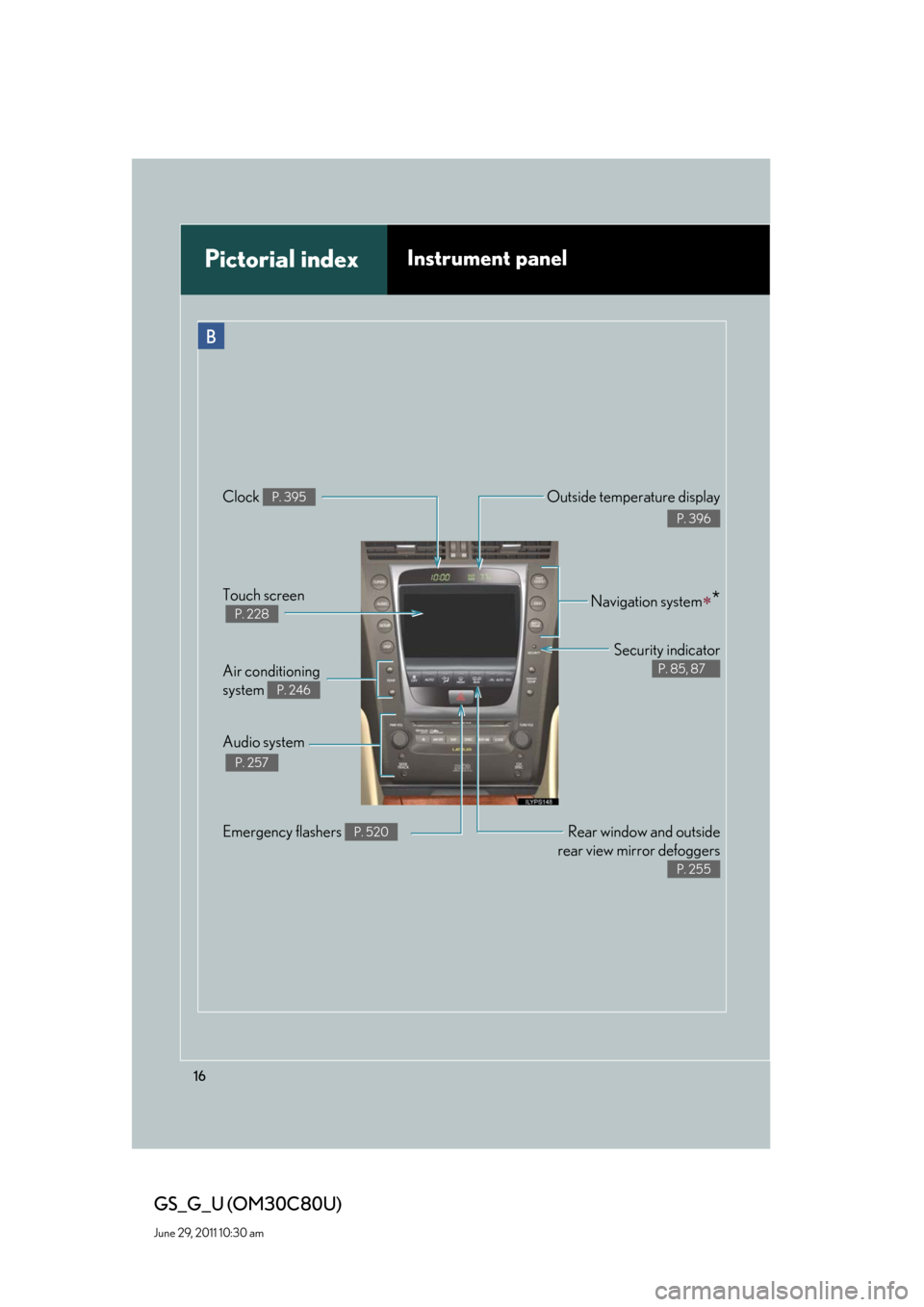air condition Lexus GS350 2010 Using The Audio System / LEXUS 2010 GS460 GS350 OWNERS MANUAL (OM30C80U)
[x] Cancel search | Manufacturer: LEXUS, Model Year: 2010, Model line: GS350, Model: Lexus GS350 2010Pages: 648, PDF Size: 15.57 MB
Page 1 of 648

TABLE OF CONTENTS
1
GS_G_U (OM30C80U)
June 29, 2011 10:30 am
1Before drivingAdjusting and operating features such as door locks, mir-
rors, and steering column
2When drivingDriving, stopping and safe-driving information
3Interior featuresAir conditioning and audio systems, as well as other interior
features for a comfortable driving experience
4Maintenance
and careCleaning and protecting your vehicle, performing do-it-your-
self maintenance, and maintenance information
5When trouble
arisesWhat to do if the vehicle needs to be towed, gets a flat tire,
or is involved in an accident
6Vehicle
specificationsDetailed vehicle information
7For ownersReporting safety defects for US owners and seat belt in-
structions for Canadian owners
IndexAlphabetical listing of information contained in this manual
Page 4 of 648

TABLE OF CONTENTSIndex
4
GS_G_U (OM30C80U)
June 29, 2011 10:30 am
3-2. Using the air conditioning system
and defogger
Automatic air conditioning
system ............................................ 246
Rear window and outside rear
view mirror defoggers ............ 255
Windshield wiper de-icer ......... 256
3-3. Using the audio system
Audio system type ....................... 257
Using the radio ............................. 260
Using the CD/DVD player...... 269
Playing an audio CD ................... 272
Playing MP3 and
WMA discs.................................. 276
Playing DVD video/audio
(with DVD player).................... 280
Playing a video CD
(with DVD player)..................... 294
CD/DVD player and DVD
video disc information ............. 297
Listening to Bluetooth
®
audio .............................................. 308
Listening to a USB memory/
iPod
®.............................................. 316
Optimal use of the audio/
video system................................ 326
Using the AUX port................... 328
Using the steering switches ..... 3293-4. Using the hands-free system
(for cellular phone)
Hands-free system
(for cellular phone) ................... 332
Using a Bluetooth
® phone ..... 338
Setting the hands-free system
(for cellular phone) .................. 353
3-5. Using the interior lights
Interior lights list........................... 382
3-6. Using the storage features
List of storage features.............. 385
3-7. Other interior features
Sun visors......................................... 393
Vanity mirrors ................................ 394
Clock ................................................ 395
Outside temperature
display ............................................ 396
Ashtrays ........................................... 397
Cigarette lighter .......................... 398
Power outlet ................................... 399
Seat heaters/ventilators ........... 400
Armrest ............................................ 402
Rear sunshade .............................. 403
Floor mats....................................... 406
Trunk features............................... 408
Garage door opener..................... 411
Compass........................................... 417
Safety Connect.............................. 421
Page 5 of 648

1
2
3
4
5
6
7
5
GS_G_U (OM30C80U)
June 29, 2011 10:30 am
4-1. Maintenance and care
Cleaning and protecting
the vehicle exterior.................. 430
Cleaning and protecting
the vehicle interior .................... 433
4-2. Maintenance
Maintenance
requirements............................... 436
General maintenance ............... 438
Emission inspection and
maintenance (I/M)
programs ....................................... 4414-3. Do-it-yourself maintenance
Do-it-yourself service
precautions .................................. 442
Hood ................................................. 445
Positioning a floor jack............... 446
Engine compartment.................. 448
Tires ................................................... 463
Tire inflation pressure................. 473
Wheels ............................................. 477
Air conditioning filter.................. 479
Electronic key battery ................ 482
Checking and replacing
fuses ................................................ 484
Headlight aim ............................... 509
Light bulbs ........................................ 512
5-1. Essential information
Emergency flashers ................... 520
If your vehicle needs
to be towed ................................... 521
If you think something is
wrong ............................................ 530
Fuel pump shut off system ......... 531
Event data recorder.................... 532
4Maintenance and care
5When trouble arises
Page 16 of 648

16
GS_G_U (OM30C80U)
June 29, 2011 10:30 am
Pictorial indexInstrument panel
Rear window and outside
rear view mirror defoggers
P. 255
Emergency flashers P. 520
Air conditioning
system
P. 246
Audio system
P. 257
Navigation system*Touch screen
P. 228
Security indicator
P. 85, 87
Clock P. 395Outside temperature display
P. 396
B
Page 33 of 648

33
1-2. Opening, closing and locking the doors and trunk
1
Before driving
GS_G_U (OM30C80U)
June 29, 2011 10:30 am
■Operation signals
A buzzer sounds and the emergency flashers flash to indicate that the doors have
been locked/unlocked. (Locked: Once; Unlocked: Twice)
■Conditions affecting operation
The smart access system with push-button start uses weak radio waves. In the fol-
lowing situations, the communication between the electronic key and the vehicle
may be affected, preventing the smart access system with push-button start, wire-
less remote control and immobilizer system from operating properly:
(Way of coping: P. 5 7 1 )
●When the electronic key battery is depleted
●Near a TV tower, electric power plant, gas station, radio station, large display,
airport or other facility that generates strong radio waves or electrical noise
●When carrying a portable radio, cellular phone, cordless phone or other wire-
less communication devices
●When the electronic key is in contact with, or is covered by the following metal-
lic objects
• Cards to which aluminum foil is attached
• Cigarette boxes that have aluminum foil inside
• Metallic wallets or bags
•Coins
• Hand warmers made of metal
• Media such as CDs and DVDs
●When multiple electronic keys are in the vicinity
●When other wireless keys (that emit radio waves) are being used nearby
●When carrying or using the electronic key together with the following devices
that emit radio waves
• Another vehicle’s electronic key or a wireless key that emits radio waves
• Personal computers or personal digital assistants (PDAs)
• Digital audio players
• Portable game systems
●If window tint with a metallic content or metallic objects are attached to the rear
window
Page 96 of 648

96
1-7. Safety information
GS_G_U (OM30C80U)
June 29, 2011 10:30 am
■SRS airbag deployment conditions (SRS front airbags)
●The SRS front airbags will deploy in the event of an impact that exceeds the set
threshold level (the level of force corresponding to an approximately 12 -
18 mph [20 - 30 km/h] frontal collision with a fixed wall that does not move or
deform).
However, this threshold velocity will be considerably higher if the vehicle strikes
an object, such as a parked vehicle or sign pole, which can move or deform on
impact, or if the vehicle is involved in an underride collision (e.g. a collision in
which the front of the vehicle “underrides”, or goes under, the bed of a truck, etc.).
●It is possible that in some collisions where the forward deceleration of the vehi-
cle is very close to the designed threshold level, the SRS front airbags and the
seat belt pretensioners may not activate together.
●The SRS front passenger airbag will not activate, if there is not passenger sitting
in the front passenger seat. However, the front passenger airbag may deploy, if
luggage is put in the seat, or the seat belt is fastened, even if the seat is unoccu-
pied. (P. 1 0 5 )
■SRS airbag deployment conditions (SRS side airbags and SRS curtain shield air-
bags)
●The SRS side airbags and SRS curtain shield airbags will deploy in the event of
an impact that exceeds the set threshold level (the level of force corresponding
to the impact force produced by an approximately 3300 lb. [1500 kg] vehicle
colliding with the vehicle cabin from a direction perpendicular to the vehicle ori-
entation at an approximately speed of 12 - 18 mph [20 - 30 km/h]).
●The SRS front side airbag on the passenger seat will not activate if there is no
passenger sitting in the front passenger seat. However, the front side airbag on
the passenger seat may deploy if luggage is put in the seat, or the seat belt is fas-
tened, even if the seat is unoccupied. (P. 105)
Page 97 of 648

97
1-7. Safety information
1
Before driving
GS_G_U (OM30C80U)
June 29, 2011 10:30 am
■Conditions under which the SRS airbags may deploy (inflate), other than a colli-
sion
The SRS front airbags may also deploy if a serious impact occurs to the underside of
your vehicle. Some examples are shown in the illustration.
■Types of collisions that may not deploy the SRS airbag (front airbags)
The SRS front airbags are generally not designed to inflate if the vehicle is involved
in a side or rear collision, if it rolls over, or if it is involved in a low-speed frontal colli-
sion. But, whenever a collision of any type causes sufficient forward deceleration of
the vehicle, deployment of the SRS front airbags may occur.
●Hitting a curb, edge of pavement or hard
surface
●Falling into or jumping over a deep hole
●Landing hard or vehicle falling
●Collision from the side
●Collision from the rear
●Vehicle rollover
Page 105 of 648

105
1
1-7. Safety information
Before driving
GS_G_U (OM30C80U)
June 29, 2011 10:30 am
Front passenger occupant classification system
Your vehicle is equipped with a front passenger occupant classification sys-
tem. This system detects the conditions of the front passenger seat and
activates or deactivates the devices for front passenger.
SRS warning light
“AIR BAG OFF” indicator light
“AIR BAG ON” indicator light
Front passenger’s seat belt reminder light
Page 106 of 648

106
1-7. Safety information
GS_G_U (OM30C80U)
June 29, 2011 10:30 am
Condition and operation in the front passenger occupant classification system
■Adult*1
■Child*3 or child restraint system*4
Indicator/
warning light“AIR BAG ON” and “AIR BAG OFF”
indicator lights“A I R B A G
ON”
SRS warning light Off
Front passenger’s seat belt reminder light
Flashing
*2
DevicesFront passenger airbag and knee airbag
Activated Side airbag in the front passenger seat
Curtain shield airbag
on the front passenger side
Front passenger’s seat belt pretensioner
Indicator/
warning light“AIR BAG ON” and “AIR BAG OFF”
indicator lights“A I R B A G
OFF”*5
SRS warning light Off
Front passenger’s seat belt reminder light
Flashing
*2
DevicesFront passenger airbag and knee airbag
Deactivated
Side airbag in the front passenger seat
Curtain shield airbag
on the front passenger side
Activated
Front passenger’s seat belt pretensioner
Page 192 of 648

192
2-4. Using other driving systems
GS_G_U (OM30C80U)
June 29, 2011 10:30 am
■The intuitive parking assist can be operated when
The “ENGINE START STOP” switch is in the IGNITION ON mode.
■When the system malfunctions
●If a malfunction occurs and no obstacles have been detected, a warning is dis-
played, and a malfunction beep sounds for 7 seconds.
If an obstacle has been detected, or another malfunction occurs in a different
sensor, the malfunction beeps will not sound.
●In the following circumstances the displayed warning will disappear:
• If you switch the screen to a different mode.
• If you turn off the intuitive parking assist main switch.
• If the vehicle speed exceeds 6 mph (10 km/h). Once the vehicle speed drops
below 6 mph (10 km/h), the warning will be displayed again.
●If the malfunction screen is displayed, the detection range of the dual sensors is
shortened. In this case, the necessity for obstacle evasion (whether the obstacle
will come within 0.8 ft. [25 cm] of the vehicle or not) will not be calculated.
■When using the intuitive parking assist
●The sensors’ detection areas and reaction times are limited. When moving for-
ward or reversing, check the areas surrounding the vehicle (especially the sides
of the vehicle) for safety, and drive slowly, using the brake to control the vehicle’s
speed.
• The sensors’ detection areas are limited to the areas around the vehicle’s front
and rear bumpers.
• Depending on the shape of the obstacle and other factors, the detection dis-
tance may shorten, or detection may be impossible.
• There will be a short delay between obstacle detection and display. Even at
slow speeds, there is a possibility that the obstacle will come within 0.8 ft. (25
cm) of the vehicle before the display is shown and the warning beep sounds.
• Braking distance may differ according to the road conditions (rain, gravel
etc.).
• It might be difficult to hear beeps due to the volume of audio system or air
flow noise of air conditioning system.
• For long obstacles such as walls, the obstacle warning may change as the
obstacle gets closer.